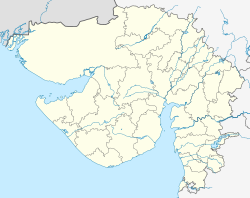This articleneeds additional citations forverification.(November 2018) |
Silvassais a city and the headquarters of theDadra and Nagar Haveli districtin Union territory ofDadra and Nagar Haveli and Daman and Diuin western India. It is today the largest city in the union territory. The city was chosen as one of the hundred Indian cities inGovernment of India's flagshipSmart Cities Mission.
Silvassa
Paço d'Arcos | |
|---|---|
City | |
 Silvassa Townhall | |
| Coordinates:20°16′15″N73°00′18″E/ 20.2708162°N 73.0049524°E | |
| Country | |
| Union territory | |
| District | Dadra and Nagar Haveli |
| Founded by | Carlos Eugénio Correia da Silva[1] |
| Government | |
| • Type | Municipal Council |
| • Body | Silvassa Municipal Council |
| • Mayor | Rakeshsinh Chauhan |
| Area | |
• Total | 16 km2(6 sq mi) |
| Elevation | 32 m (105 ft) |
| Population (2011) | |
• Total | 98,266 |
| • Density | 6,100/km2(16,000/sq mi) |
| Languages | |
| • Official | |
| • Additional official | Gujarati[2] |
| Time zone | UTC+5:30(IST) |
| Telephone code | 0260 |
| Vehicle registration | DD-01 |
| Website | dnh |
Etymology
editThe former official name of the city, duringPortugueserule, wasPaço de Arcos(Engl.: "palace of arches", also spelledPaço d'Arcos),[3]named after the town ofthat same namelocated inOeiras,Lisbon.[4]
History
editUntil about theturn of the century,in the late 1800s, Silvassa was one of many small villages inPortuguese India.Its importance started to increase by the mid-1880s when the Portuguese administration, under then Governor-GeneralCarlos Eugénio Correia da Silva, Count of Paço de Arcos,decided to transfer the seat of thePragana Nagar Avelymunicipality further inland fromDarará.On 11 February 1885, by decree from the Portuguese Ministry of the Overseas, Silvassa was designated as a town (vila), and given the name of Paço de Arcos.[5]However, the endemic name prevailed, and the town continued to be known locally and beyond as Silvassa, being referred-to as such in official documents. The town remained the municipal capital until theIndian Annexation of 1954.
Demographics
editAccording to the 2011 Indiacensus,[6]Silvassa had a population of 98,265.
Language
editGujaratiandHindiare the most commonly spoken languages in Silvassa; as the city lies in the northern part ofNagar Haveli,Gujarati and its dialects are more widely spoken compared to the southern part of Nagar Haveli, whereMarathi,Konkaniand its dialects hold prominence. As with most larger towns and cities in India (with a somewhat centralised location), Silvassa is home to people from virtually every part of the nation, with numerous languages being spoken there besides the widespread Hindi, Marathi or Gujarati; one may hearBengali,Bhojpuri,Haryanvi,Kannada,Malayalam,Marwari,Odia,Punjabi,Tamil,TeluguorUrdu,amongst other tongues, when in Silvassa.
As a former Portuguese colony, Silvassa has a significantRoman Catholicpopulation, and there are still a few citizens who speakPortugueseas their first or second language.
Industry
editFar from being a tribal region, Silvassa has now developed into an industrial hub with major industrial companies setting up manufacturing bases in the region. Its initial tax-free status granted by the Indian government to boost industrial investment in the former Union Territory of Dadra and Nagar Haveli has contributed to the region's industrial growth.[citation needed]The industrial landscape of Silvassa and surrounding region has been altered dramatically. It is one of the largest states in collection of excise duty from more than 3,500 small and medium industries. Silvassa is a big hub for plastic products and its products are found throughout India thanks to their good quality and low cost. Apart from all this, Silvassa is also known for various FMCG distributors like Gajra Distribution having reach throughout the country.
Silvassa hosts more than 200,000 floating population, coming from all parts of the country; the laborers mostly hail from Uttar Pradesh, Bihar and Odisha. Other floating community is from the states of Madhya Pradesh, Maharashtra, Gujarat, Kerala, Karnataka, Tamil Nadu, Andhra Pradesh, and Rajasthan.
Transport and connections
editSilvassa is connected to Maharashtra and Gujarat viaNational Highway 848A.[7]Silvassa has a well-maintained road network. The nearest railway stations are inVapi16 kilometres (9.9 mi) away andBhilad,14 kilometres (8.7 mi) away. Daman is 30 km away via Bhilad on National Highway number 8. Mumbai is 160 km away from Silvassa, via Bhilad, on National Highway number 8 Surat is 130 km away from Silvassa, viaBhilad,on National Highway number 8. Auto-rickshaw services ply between Vapi and Silvassa at a regular interval and easily available from Vapi (E) railway station. Gujarat Road Transport Buses ply between Silvassa and Vapi at a regular interval.
Silvassa Smart City Limited currently operates 10 Electric Buses to and from the Silvassa Bus Stand, destinations include Daman, Vapi, Khanvel, Dudhani, and Mandoni.
See also
editReferences
edit- ^"Dadra And Nagar Haveli At Glance".
- ^"The Goa, Daman and Diu Official Language Act, 1987"(PDF).indiacode.nic.in.Retrieved12 November2022.
- ^"Church of Our Lady of Piety".The Times of India.
- ^"Silvassa – A City with Portugal History".29 July 2017.
- ^"Decreto de 11 de fevereiro de 1885",Diário do Governo,1885
- ^"Census of India 2001: Data from the 2001 Census, including cities, villages and towns (Provisional)".Census Commission of India. Archived fromthe originalon 16 June 2004.Retrieved1 November2008.
- ^"New National Highways notification - NH 848A"(PDF).The Gazette of India.17 April 2013.Archived(PDF)from the original on 21 May 2018.Retrieved20 May2018.


